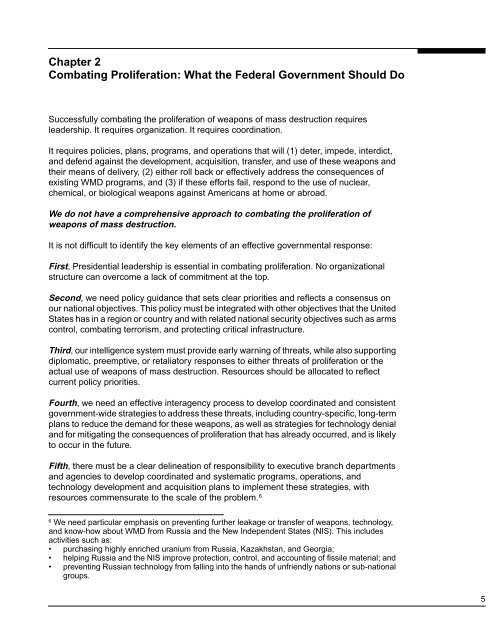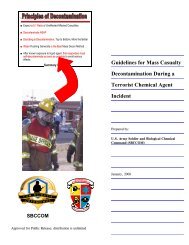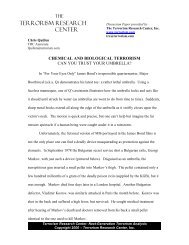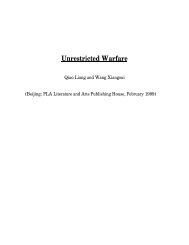Combating Proliferation of Weapons of Mass Destruction
Combating Proliferation of Weapons of Mass Destruction
Combating Proliferation of Weapons of Mass Destruction
You also want an ePaper? Increase the reach of your titles
YUMPU automatically turns print PDFs into web optimized ePapers that Google loves.
Chapter 2<strong>Combating</strong> <strong>Proliferation</strong>: What the Federal Government Should DoSuccessfully combating the proliferation <strong>of</strong> weapons <strong>of</strong> mass destruction requiresleadership. It requires organization. It requires coordination.It requires policies, plans, programs, and operations that will (1) deter, impede, interdict,and defend against the development, acquisition, transfer, and use <strong>of</strong> these weapons andtheir means <strong>of</strong> delivery, (2) either roll back or effectively address the consequences <strong>of</strong>existing WMD programs, and (3) if these efforts fail, respond to the use <strong>of</strong> nuclear,chemical, or biological weapons against Americans at home or abroad.We do not have a comprehensive approach to combating the proliferation <strong>of</strong>weapons <strong>of</strong> mass destruction.It is not difficult to identify the key elements <strong>of</strong> an effective governmental response:First, Presidential leadership is essential in combating proliferation. No organizationalstructure can overcome a lack <strong>of</strong> commitment at the top.Second, we need policy guidance that sets clear priorities and reflects a consensus onour national objectives. This policy must be integrated with other objectives that the UnitedStates has in a region or country and with related national security objectives such as armscontrol, combating terrorism, and protecting critical infrastructure.Third, our intelligence system must provide early warning <strong>of</strong> threats, while also supportingdiplomatic, preemptive, or retaliatory responses to either threats <strong>of</strong> proliferation or theactual use <strong>of</strong> weapons <strong>of</strong> mass destruction. Resources should be allocated to reflectcurrent policy priorities.Fourth, we need an effective interagency process to develop coordinated and consistentgovernment-wide strategies to address these threats, including country-specific, long-termplans to reduce the demand for these weapons, as well as strategies for technology denialand for mitigating the consequences <strong>of</strong> proliferation that has already occurred, and is likelyto occur in the future.Fifth, there must be a clear delineation <strong>of</strong> responsibility to executive branch departmentsand agencies to develop coordinated and systematic programs, operations, andtechnology development and acquisition plans to implement these strategies, withresources commensurate to the scale <strong>of</strong> the problem. 66We need particular emphasis on preventing further leakage or transfer <strong>of</strong> weapons, technology,and know-how about WMD from Russia and the New Independent States (NIS). This includesactivities such as:• purchasing highly enriched uranium from Russia, Kazakhstan, and Georgia;• helping Russia and the NIS improve protection, control, and accounting <strong>of</strong> fissile material; and• preventing Russian technology from falling into the hands <strong>of</strong> unfriendly nations or sub-nationalgroups.5







